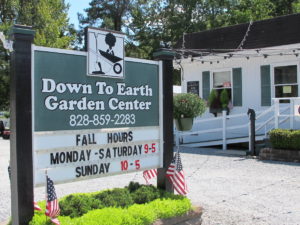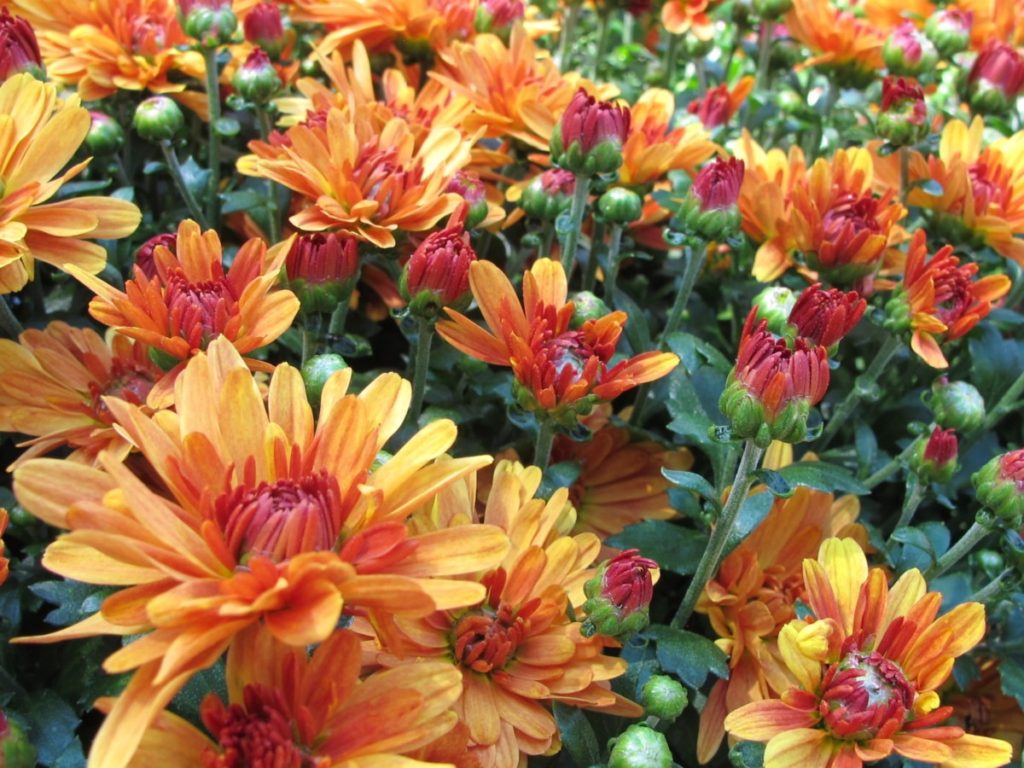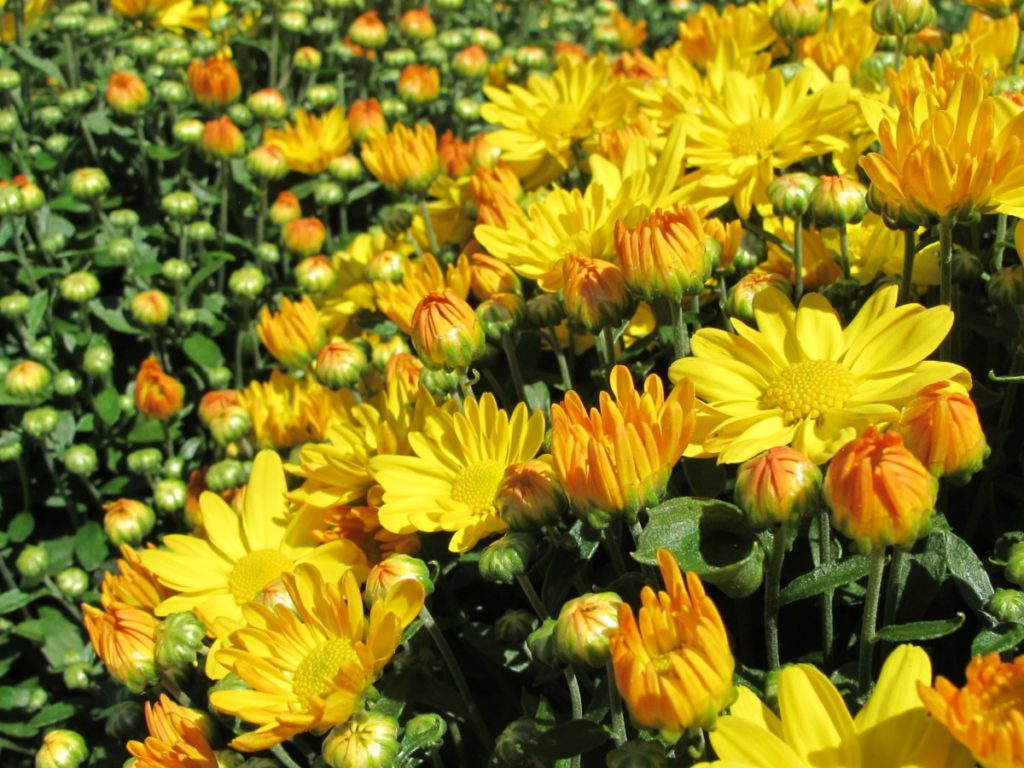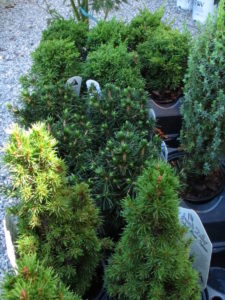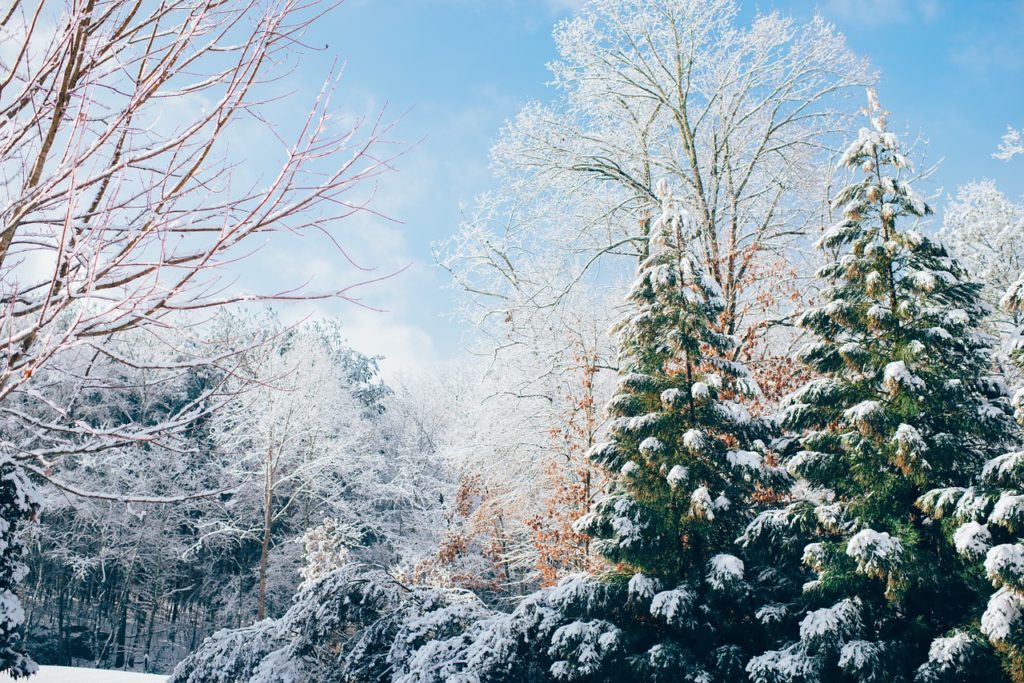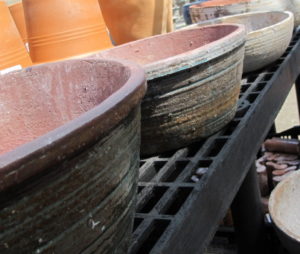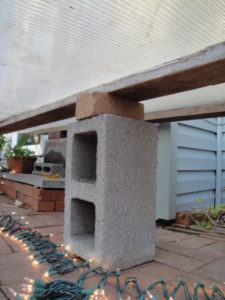Down To Earth Garden Center, and Planting a Miniature Garden
On a recent drive to the mountains of North Carolina, I passed by Down To Earth Garden Center. Maybe it was the charming picket fence, or the need to save time and buy a few packs of vegetables for the deck pots. Either way, the inviting entrance lured me back.
Plus, when living in West Virginia, waaaay back in the 1970’s, I wholesaled potted houseplants to a popular shop called Down To Earth, in the downtown Morgantown retail district. Fond memories…
Down To Earth Garden Center is located at 1080 South Trade Street, in Tryon NC. Fran and Gary Garside are the owners, and Kiara and Dylan offered friendly greetings and help. After a quick turn around the yard, I asked permission to take a few photographs for the blog. Oliver, the friendly terrier, had no objections, either.
Here’s another small but meticulously maintained garden center.
Check out their facebook page, Down To Earth Garden Center, in Tryon NC.
Phone: 828 859-2283. Call for new hours.
- Chrysanthemums…
- …for warm autumn color.
The Newest Project
An empty blue ceramic pot sits in our front garden, begging for employment. A while ago, I sowed a pack of older zinnia seeds in it, but they didn’t germinate. So, the pot is looking for work. Construction on our home and others in the neighborhood this summer prohibited any large scale gardening, so I’m eager to exercise some creative horticulture before frost.
Seeing the dozen or so varieties of hardy dwarf evergreens at Down To Earth Garden Center, I instantly knew what my next project would be. The pot to be planted is roughly 16″ square and 8″ deep. There’s plenty of room for a collection of miniatures, some rocks and gravel, and driftwood with character.
The term “driftwood” is loosely applied here, referring to any piece of weathered wood or woody root. Most of the small pieces I’ve gathered have come from the woods, not from a body of water.
Fairy Gardens
In recent years, this style of garden has been called a “fairy garden”, but some gardeners simply refuse to call it that. Let’s just call them miniature gardens. If you or your grandchildren want to dress them up with happy gnomes and resin residences, go right ahead. But for me, a natural landscape is the way to go.
By the way, this is not a new trend in gardening. I remember planting terrariums for a florist in New Jersey, more than 4 decades ago. I used dwarf tropicals, driftwood, rocks and gravel, and life-like little “faux” mushrooms. Merchandisers, however, have captured attention from new audiences by calling them fairy gardens.
Any hobby shop you visit will be stocked with associated paraphernalia, from named fairies and cute cottages to stone staircases. This could be a fun introduction into gardening for our younger folks.
Tropicals For a Miniature Garden
Although I will be constructing a garden using cold-hardy species, you might prefer using tropicals for indoor gardens. Garden centers stock miniature plants in 1 1/2″ to 2″ pots for this purpose. You’ll find them as stores gear up for the busy fall (or spring) growing season, but many stock them year-round.
Some species stay small while others eventually will grow too large for a miniature garden. But for a year or so, they’ll do fine. You can find all sorts of ferns, Nephthytis, young palms, peperomia, pilea, baby tears, little succulents for sun, philodendron, and pothos. Young trees, such as Podocarpus, aralia (Polyscias), dracaena, Serissa, and Norfolk Island pine also are available.
Little Evergreens For the Miniature Garden
Picea and Thuja
From Down To Earth, I selected Picea abies ‘Jana’, a Norway spruce, and Picea glauca ‘Blue Planet’, a white spruce. Each of these globular evergreens grows only 1″ to 2″ in a year when planted in the garden, and less than that in a pot. Their needles are a whopping 1/4″ to 1/3″ long!
Upright growing Thuja occidentalis ‘Primo’, an eastern arborvitae, grows 2″ to 4″ per year, and will serve as a vertical accent in the composition. Dwarf conifers are perfect for trough gardens, rock gardens, and also for outdoor railway layouts.
(***Update***: Each of the spruces grew less than 1″ this past year, and ‘Primo’ added only 1 1/2″ in height. All plants look great, although ‘Jana’ burned a bit at the top during a long stretch of hot weather—100°F heat index. 8/25/2020)
‘Primo’ could easily be mistaken for its cousin, Chamaecyparis, a well-loved genus which I often included in customers’ landscapes and in mine. This dwarf arborvitae has dense fans of tightly-packed foliage whorled around its stems—fabulous textural interest! ‘Primo’ was selected from a crop of seedlings at Iseli Nursery in 2004, and was released to the trade in 2017. Its foliage can take on deeper green to bronze tints in cold weather. When planted in the garden, this variety will grow to about 3′ tall and 1 1/2′ wide in 10 years.
A Holly Called ‘Jersey Jewel’
Down To Earth also had dwarf junipers, Cotoneaster, a ferny Chamaecyparis, and a holly with the cutest and tiniest round leaves. It was difficult narrowing down the choices to 3 plants. Hmmm…I might have to go back for that holly. (***Update***: A couple of months later, I did go back for that holly, Ilex crenata ‘Jersey Jewel’, when my visiting brother, Jeff, and I went for a drive in the mountains.)
The Cold Facts
All 3 dwarf evergreens are hardy to minus 30°F, or USDA zone 4. Because they will be kept above ground level, in the pot, their roots will not be insulated by surrounding garden soil. On an average winter night here in zone 7b (borderline 8a), however, the soil probably will freeze only an inch or two into the pot. I’m more concerned about summer heat in this area.
So, how, then, do spruces and firs survive way up in the frigid north? First, they evolved there, and their cellular chemistry has adapted to harsh conditions. Second, a blanket of snow and a layer of forest floor debris help protect plants’ roots, to a degree, even if air temperatures plummet to well below 0°. And those are the full-sized specimens, with roots that venture more deeply than the tiny evergreens I’ll be using in the pot.
Other Variables
Large pots in winter sunlight absorb more heat than small ones during the daytime, and release it to the atmosphere at night. And the more hours of sun, the better. You can see how a larger soil mass offers better protection from the cold than a smaller one. It takes more time for a greater volume of soil to release the warmth gathered during the daytime.
Consider, also, the color of the pot. Dark pots absorb more energy from the sun, sometimes making the difference between life and death for their inhabitants. In this case, I already have the blue pot, and it’s a light shade of blue at that. But later I’ll describe other tricks we can employ when dealing with harsh winter weather.
This container has survived many winters outdoors without cracking because it’s frost resistant. Still, there are no guarantees. For those pots that have great value to you, empty and clean them, and store them upside down in the shed or the garage.
Within reasonable limits, most of us in the U.S. can find something to grow in winter pots. Just look for the hardiest specimens you can find, and get some advice from an expert at your local garden center. If live plants are out of the question, consider berried stems, colorful twigs, cut greens, moss, pine cones, and other seasonal ornamentation for the decorative pots by the front door. Or you might choose to take the risk with live plants.
In Unusually Cold Conditions
Hardiness Zones
Each variety of tree, shrub, and perennial is assigned a winter hardiness zone. That zone represents the lowest temperatures it can tolerate when planted in the ground. It’s useful when labels include the range of tolerance, such as “USDA zones 4-7”.
Regions on the USDA plant hardiness zone map are divided in ten-degree increments. The additional “a” or “b” designation further narrows down each zone to slightly cooler or slightly warmer parts, respectively. So, zone 7b is 5° warmer in winter, on average, than zone 7a. The zone numbers increase as average winter temperatures increase from Canada to the southern U.S.
It’s not unusual in this area of North Carolina to see temperatures drop into single digits a few nights each winter. And, conversely, we sometimes have those glorious winters that rarely get below 25°! Normally, I recommend using plants for planters that are rated two zones hardier than the zone you’re living in. For example, a zone 5 Pieris japonica that should tolerate winter temperatures as low as -20° planted in the ground likely will survive a zone 7 winter (0° to 10°F) in a pot.
The Weather Report
The last weather report of the day will determine if anything needs to be done for the plants outside. I’ll probably move the miniature garden to the warmer back deck, which is protected by a fence. That’s where plants, including edibles in pots, will get the most hours of direct sun.
The corner between the shed and the back wall provides a cozy microclimate. And, if needed, I can move the miniature garden into the shed or indoors for the night. But I’d rather not; it’s rather heavy.
Cold Frames
Let’s say you live in the cold northern states, but you want to pot up a miniature conifer garden. You’ll need to provide some protection when temperatures drop so low that the plants are at risk. Here are a few suggestions for those areas where these conditions last for months.
Move the pot into a sunken cold frame, or one that is lightly heated by a heat mat or heat cables. Heeling (burying) the pot into the soil, inside the cold frame, will give more protection by insulating the root system. Or you could pile mulch around the pot up to the rim.
Where winter conditions are cold but not severe, heeling in the pot next to a south-facing wall might be all the protection required. Or move it to a covered sunny porch against the wall of the house. Avoid placing it where ice or snow from the roof might fall on the plants. Watch out for animals that like to dig. Surround the planting with deer netting or a wire barrier (chicken wire, hardware cloth) to prevent damage.
The cold side of a heated greenhouse, an unheated lean-to, a minimally heated sunroom, or a sunny garage window might work during the frigid winter months. The plants will need direct sun even though they’re dormant in winter, but keep them very cool. And don’t forget to water! When cold, the miniature garden will dry very slowly, but it still needs to be checked.
If it’s too warm, the plants will beak dormancy prematurely. But, without adequate sun, that new growth will be weak.
Here’s A Bright Idea
Another option is to surround the pot and soil with a string of indoor/outdoor miniature incandescent lights. Enclosing the whole thing, or just the pot, in plastic at night creates a “lightly” heated bubble of protection.
I’ll use this simplified version of a cold frame during periods of severe cold, meaning temperatures in single digits at night. But I probably won’t wait for the temperature to drop that low. These varieties are new to me, and I don’t want to lose them.
In the Maryland back yard, I assembled the cold frame (photo, right) every autumn. Succulents, geraniums, cyclamen, and other plants that tolerated cool temperatures, but not frost, spent the winters there. Edible cool season greens grew continuously under cover. And all received abundant sunlight in the back yard, on the south side of the house.
Cinderblocks and boards supported sheets of durable twinwall polycarbonate above the patio. Extra bricks on the north side (above cinder blocks) helped slope the cold frame toward the south for drainage and a better orientation toward winter sun. I used clear 4-mil plastic to cover the entire frame, sealing up the sides. And I weighed it down so it wouldn’t blow away.
The purpose of the strings of Christmas lights is to give gentle warmth, not light. So, use incandescent lights, not LED’s. The number of strings used in the cold frame varied with outdoor temperatures and with the amount of warmth needed for a particular group of plants. A string of 100 mini lights provides about the same warmth as a 40-watt light bulb.
Keeping Their Cool
These evergreens grow best when exposed to natural seasonal variations. But because the roots are above ground, they are more limited in what they can tolerate.
In any case, don’t keep hardy plants on display indoors or enclosed under plastic any longer than necessary. They might break dormancy, and could suffer cold damage when exposed to normal temperatures again. Open or remove the plastic covering every morning, before the sun heats the space.
Headings
Page 1: Down To Earth Garden Center, and Planting a Miniature Garden, The Newest Project (Fairy Gardens, Tropicals For a Miniature Garden, Little Evergreens For the Miniature Garden (Picea and Thuja, A Holly Called ‘Jersey Jewel’), The Cold Facts (Other Variables), and In Unusually Cold Conditions (Hardiness Zones, The Weather Report, Cold Frames, Here’s a Bright Idea, Keeping Their Cool)
Page 2: Tips for Potting Up the Miniature Garden (Double Potting), Plants For the Miniature Garden (Bloomers, Hardy Plants, Moss, Pruning), The Blue Pot, The Off-Centerpiece, More Plants For the Miniature Garden (Let’s Start Planting), The Little Fillers For the Miniature Garden (Acorus, Carex, and Ophiopogon, Eleocharis, A Welcome Weed and Viola), and The Small Stuff
